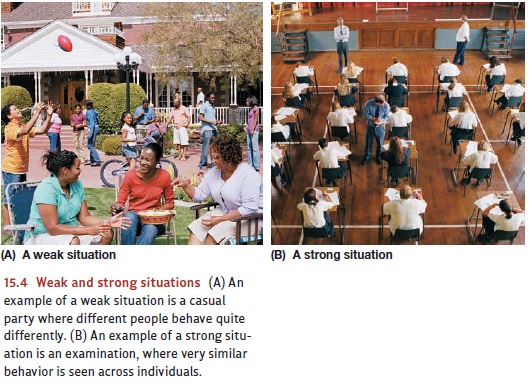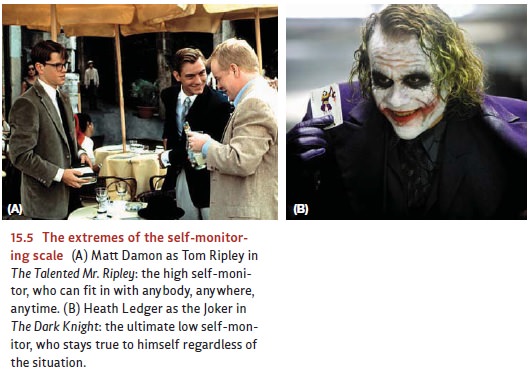Chapter: Psychology: Personality
The Trait Approach: The Consistency Controversy

The
Consistency Controversy
Whether
they endorse the Big Five dimensions or not, trait theorists agree that
individ-uals’ personalities can be described in terms of stable and enduring
traits. After all, when we say that someone is friendly and warm, we are doing
more than describing how he acted on a particular occasion. Instead, we are
describing the person and, with that, providing some expectations about how he
will act on other occasions, in other settings. But is this right? Is someone’s
behavior stable in this way?
HOW CONSISTENTARE PEOPLE ?
In
one classic study, researchers examined the behavior of schoolchildren—and, in
par-ticular, the likelihood that each child would be dishonest in one setting
or another (Hartshorne & May, 1928). Quite remarkably, the researchers
found little consistency in children’s behavior: Children who were inclined to
cheat on a school test were often quite honest in other settings (e.g., an
athletic contest), and vice versa. Based on these findings, it would be
misleading to describe these children with trait labels like “honest” or
“dishonest”—sometimes they were one, and sometimes the other.
Some
40 years ago, Walter Mischel reviewed this and related studies, and concluded
that people behave much less consistently than a trait conception would
predict, a state of affairs which has been referred to as the personality paradox (Mischel, 1968). Thus,
for example, the correlation between honesty measured in one setting and
honesty measured in another situation was .30, which Mischel argued was quite
low. Mischel noted that behaviors were similarly inconsistent for many other
traits, such as aggres-sion, dependency, rigidity, and reactions to authority.
Measures for any of these, taken in one situation, typically do not correlate
more than .30 with measures of the same traits taken in another situation.
Indeed, in some studies, there is no detectable corre-lation at all (Mischel,
1968; Nisbett, 1980). These findings led Mischel to conclude that trait
conceptions of personality dramatically overstate the real consistency of a
person’s behavior.
WHY AREN ’T PEOPLE MORE CONSISTENT ?
How
should we think about these results? One option is to argue that our
personalities are, in fact, relatively stable just as the trait approach
suggests, but acknowledge that situations often do shape our behavior. Given a
red light, most drivers stop; given a green light, most go—regardless of
whether they are friendly or unfriendly, stingy or generous, dominant or
submissive. Social roles likewise often define what people do independent of
their personalities. To predict how someone will act in a courtroom, for
example, there is little point in asking whether he is sociable, careless with
money, or good to his mother. What we really want to know is the role that he
will play—judge, prosecutor, defense attorney, or defendant.
We
reviewed studies indicating that the influence of a situation can be incredibly
powerful—leading ordinary college students to take on roles in which they are
vicious and hurtful to their peers. It’s no wonder, then, that there is
sometimes lit-tle correspondence between our traits and our behavior and less
consistency in our behavior than the trait perspective might imply. The reason,
in brief, lies in what’s called the power
of the situation. Because of that power, our behavior often depends more on
thesetting we are in than on who we are.
Sometimes,
though, our behavior does depend on
who we are. Particularly in weak situations—ones in which the environment
provides few guides for our behavior—our personalities shape our actions
(Figure 15.4). Even in strong situations—ones in which the environment provides
clear guides for our behavior—different people react to the situation in
somewhat different ways, so that their behavior in the end reflects the inter-action of the situation with their
personality (Fleeson, 2004; Magnusson & Endler,1977). Moreover, it’s not a
matter of chance how a particular person reacts to this situation or that one;
instead, people seem to be relatively consistent in how they act in certain types of situations. Thus, for example, someone
might be punctual in profes-sional settings, but regularly late for social
occasions; they might be shy in larger groups, but quite outgoing when they are
with just a few friends.

Evidence
for these points comes from many sources, including a study in which chil-dren
in a summer camp were observed in a variety of situations—settings, for
example, in which they were teased or provoked by a peer, or settings in which
they were approached in a friendly way by a peer, or settings in which they
were scolded by an adult (Cervone & Shoda, 1999; Mischel, Shoda, &
Mendoza-Denton, 2002). In this study, the researchers relied on behavioral data—data based on
observations of specific actions— and these data showed that each child’s
behavior varied from one situation to the next. For example, one child was not
at all aggressive when provoked by a friend, but responded aggressively when
scolded by an adult. Another child showed the reverse pat-tern. Thus, the trait
label aggressive would not
consistently fit either child—sometimes they were aggressive and sometimes they
were not.
There
was, however, a clear pattern to the children’s behavior, but the pattern
emerges only when we consider both the person and the situation. As the
investigators described it, the data suggested that each of the children had a
reliable “if . . . then . . .” profile: “If in this setting, then act in this
fashion; if in that setting, then act in that fashion” (Mischel et al., 2002).
Because of these “if . . . then . . .” patterns, the children were, in fact,
reason-ably consistent in how they acted, but their behaviors were “tuned” to
the situations they found themselves in. Thus, we need to be careful when we
describe any of these children as being “friendly” or “aggressive” or
“helpful,” relying only on global trait labels. To give an accurate
description, we need to be more specific, saying things like “tends to be
friendly in this sort of setting,” “tends to be helpful in that sort of
setting,” and so on.
ARE SOME PEOPLE MORE INFLUENCED BY THE SITUATION THAN OTHERS ?
There
is one more complexity we must keep in mind as we consider how personality and
situations interact to shape behavior. Some individuals are more consistent
than others across situations, or, turning this around, some individuals are
more flexible than others. This difference among people is assessed by the Self-Monitoring Scale, developed by
Mark Snyder and designed to assess the degree to which people are sen-sitive to
their surroundings and likely to adjust their behaviors to fit in. The scale
includes items such as “In different situations and with different people, I
often act like very different persons.”
High
self-monitors care a great deal about how they appear to others, and so, at a
cocktail party, they are charming and sophisticated; in a street basketball
game, they “trash talk.” In contrast, low self-monitors are less interested in
how they appear to

others.
They are who they are regardless of the momentary situation, making their
behavior much more consistent across situations (Figure 15.5; Gangestad &
Snyder, 2000; M. Snyder, 1987, 1995). This suggests that the extent to which
situations deter-mine an individual’s behavior varies by person, with
situations being more important determinants of high self-monitors’ behavior
than of low self-monitors’ behavior.
How
consistent individuals are also varies at the cultural level of analysis.
Americans, for example, are relatively consistent in how they describe
themselves, no matter whether they happen at the time to be sitting alone, next
to an authority figure, or in a large group (Kanagawa, Cross, & Markus,
2001). By contrast, Japanese partici-pants’ self-descriptions varied
considerably across contexts, and they were far more self-critical when sitting
next to an authority figure than when they were by themselves. There also
cultural differences in how consistent individuals want to be. In one study, researchers asked American and Polish
participants how they would respond to a request to take a survey about
beverage preferences. When asked to imagine they had previously agreed to such
requests, American participants said they would again agree to the
request—apparently putting a high value on self-consistency. Polish
partici-pants, by contrast, were much less concerned with self-consistency, and
so were less influenced by imagining that they had agreed to similar requests
in the past (Cialdini, Wosinka, Barrett, Butner, & Gornik-Durose, 1999).
Related Topics